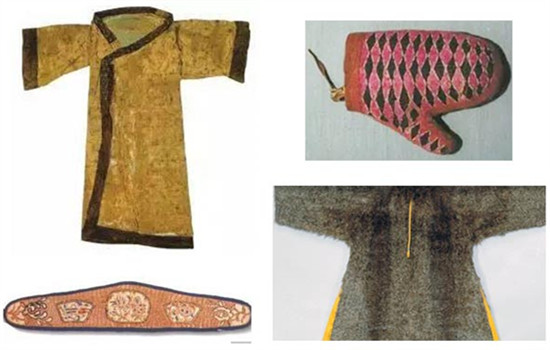
From above left, clockwise: An ancient windcoat, an embroidery diamond-pattern glove from Northern dynasties, a fox-fur overcoat worn by Emperor Qianlong of the Qing Dynasty, a head wear. (File photo)
Although it is chilly outside in winter, we have heating systems to keep us warm indoors in most parts of North China, and in South China, they at least have air conditioners or electric radiators. But how did ancient people in China keep warm without these modern appliances?
Temperature adjustable room daubed with pepper mash
During the Qin (221-206 BC) and Han (206 BC-220) dynasties, temperature adjustable rooms emerged in royal families. Royal court had larger and more advanced rooms, called the "temperature adjustable hall". Imperial palaces such as Changle Palace and Weiyang Palace in Western Han Dynasty (206 BC-AD 24) had temperature adjustable halls. Changle Palace was originally used as the government's "office building" and "president suite" for Liu Bang (the first emperor of the Han Dynasty), and then was used as the residence of empress dowagers. Changle Palace not only had heating rooms for winter, but also rooms for cooling down in summer.
These halls were also a good place to store books as a comfortable temperature could help preserve books and provide a better environment for reading.
It is said that the "temperature adjustable hall" was built with pepper mash daubed on the wall, embroidery tapestries hung on the wall and a thick blanket paved on the ground. Windshield screens and wild goose feather-made curtains were also used to keep cool air outside.
Ground heating system
Kitchen range made with sun dried mud bricks were also found in Han Dynasty ruins which was equipped with discharge flue. In addition, a fireplace was found beside the wash bath at the ruins of Xianyang Palace dating from the Qin Dynasty.
During the Ming (1368-1644) and Qing (1644-1912)dynasties, a ground heating system was used indoors, which was built by concreting circular flue underground. The charcoal fire smoke would flow through channels to the whole room and raise the temperature indoors. The ground heating system enabled the room heat up evenly and mildly. As the fiery pit and smoke jack was set outdoors, the heating method was safe, clean and practical.
The ground heating system wasn't invented by Ming and Qing dynasty people. It emerged as early as Wei and Jin dynasties (AD 220-420). The historical record shows that the northeast part of China had used fire pits to keep warm during that time, which functioned similarly as a ground heating system.


















































